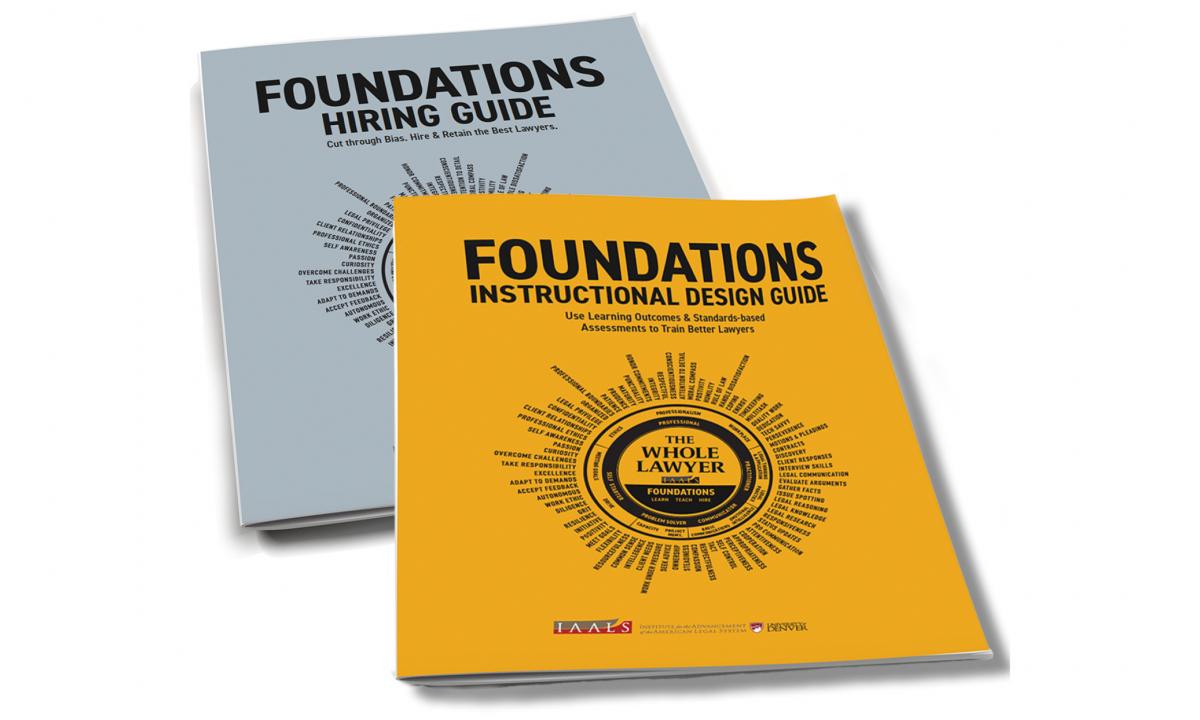IAALS Releases New Tools to Cut through Bias in Legal Hiring and Improve Legal Education Outcomes
Two first-of-their-kind guides provide data-driven pathways for law firms and law schools to implement Foundations-based practices and foster a more diverse profession
 IAALS, the Institute for the Advancement of the American Legal System, released two new guides—an Instructional Design Guide and a Hiring Guide—which detail innovative ways for legal educators and legal employers to implement data-driven, outcomes-based standards underpinned by IAALS’ Foundations for Practice research. The guides, which stem from a survey of 24,000 lawyers and working sessions with 36 employers and 4 law schools, provide law schools with a path to train better lawyers and employers a path to hire and retain the best lawyers.
IAALS, the Institute for the Advancement of the American Legal System, released two new guides—an Instructional Design Guide and a Hiring Guide—which detail innovative ways for legal educators and legal employers to implement data-driven, outcomes-based standards underpinned by IAALS’ Foundations for Practice research. The guides, which stem from a survey of 24,000 lawyers and working sessions with 36 employers and 4 law schools, provide law schools with a path to train better lawyers and employers a path to hire and retain the best lawyers.
“The Foundations guides are a natural continuation of Foundations for Practice, launched in 2014,” explained Logan Cornett, IAALS Director of Research. “We conducted the largest study of its kind to identify the characteristics, competencies, and skills—what we call foundations—that new lawyers need to be successful. Now, as our country reckons with systemic racism, implicit bias, a shifting economy, and lack of access to justice, the Foundations data and tools provide new ways for the legal profession to rise to the occasion.”
By targeting both legal education and legal employment, Foundations aims to strengthen both. The status quo has been a cycle of tradition: teaching classes the way they always have been taught and hiring lawyers based on where they went to law school and their class rank. But now, the empirical research of Foundations provides pathways for schools and law firms to evolve and better ensure the success for all new lawyers, but especially for those who are less advantaged because of race, gender, or socioeconomic background. The Foundations suite of tools offers novel and innovative means to create alignment between law schools and legal employers, and to effectively address structural problems inherent in the status quo of the legal profession.
The Foundations Instructional Design Guide is for educators who want to improve curriculum by designing and implementing learning outcomes and standards-based assessments. Through close review of course objectives, defining desired learning outcomes from students, and creating assessments and rubrics to match, legal educators can better prepare lawyers for practice. The Foundations Hiring Guide is for employers who want to improve their hiring practices—to improve quality, retention, and diversity. Through close review of hiring criteria, designing objective ways to assess candidates for hire, and creating accountability measures, employers can cut through bias and hire and retain lawyers that will excel.
“The urgency for updating how we teach, assess, and hire budding lawyers has never been greater,” says Zachariah DeMeola, IAALS Director of Legal Education and the Legal Profession. “We’ve already seen how employers that adopt our suggested practices position themselves to achieve better hiring outcomes. That’s because Foundations-based hiring  results in evaluating candidates based on well-articulated needs—as defined by the organization’s practice, vision, and goals. In one firm that adopted Foundations-based hiring practices, we saw reduced influence of bias and a broader pool of candidates, which increased the scope of diversity for new hires. Now is the time for us to expand the reach of this work, making it accessible and easy to implement—that is the goal of these guides.”
results in evaluating candidates based on well-articulated needs—as defined by the organization’s practice, vision, and goals. In one firm that adopted Foundations-based hiring practices, we saw reduced influence of bias and a broader pool of candidates, which increased the scope of diversity for new hires. Now is the time for us to expand the reach of this work, making it accessible and easy to implement—that is the goal of these guides.”
The guides are the first set of tools created for the next phase of Foundations for Practice, which will address different pathways to improve education, hiring, and professional development—Foundations for Learning, Foundations for Teaching, and Foundations for Hiring. IAALS has also begun consulting with law schools and employers to put these processes into practice. Through these engagements, our experts work directly with schools and law firms to implement Foundations-based practices including, for example, assisting a law school to map learning outcomes to its curriculum, working with a professor to employ learning outcomes in designing courses, offering insight to students for better directed learning, and helping a law firm define the foundations their employees need to succeed.


